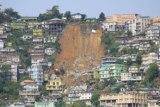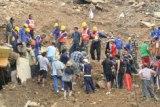THE LANDSLIDE OF AIZAWL
THE LANDSLIDE OF AIZAWL
HOPE AMIDST DESPAIR
 Every monsoon, hilly states like Mizoram often bear the brunt of nature’s force in the form of landslides. During the rainy season, the young and unstable topography, heavy rainfall, the rapid pace of rampant urbanization, deforestation and denudation of hilly slopes are potent factors that make nature’s time-bomb tick faster. Aizawl, which unlike other capital cities of North East India is spread across the spur of a hill range and Gangtok that too, is built on a hilly slope though the altitude and terrain being different are much more prone to such acts of nature. While the monsoon brings a sigh of relief and a fresh lease of life in the rest of the country; in the hilly states of the North East it often brings forth uncertainty and destruction.The monsoon here is the most trying time as landslides cut off vital roads snapping all links with the world, sometimes for weeks. Earthquakes are another Damocles sword that hangs over the region as the entire North East region falls under Zone 5 on the seismic scale referred to as the Very High Damage Risk Zone. Sikkim was put to the test in 2011 when an earthquake struck it.
Every monsoon, hilly states like Mizoram often bear the brunt of nature’s force in the form of landslides. During the rainy season, the young and unstable topography, heavy rainfall, the rapid pace of rampant urbanization, deforestation and denudation of hilly slopes are potent factors that make nature’s time-bomb tick faster. Aizawl, which unlike other capital cities of North East India is spread across the spur of a hill range and Gangtok that too, is built on a hilly slope though the altitude and terrain being different are much more prone to such acts of nature. While the monsoon brings a sigh of relief and a fresh lease of life in the rest of the country; in the hilly states of the North East it often brings forth uncertainty and destruction.The monsoon here is the most trying time as landslides cut off vital roads snapping all links with the world, sometimes for weeks. Earthquakes are another Damocles sword that hangs over the region as the entire North East region falls under Zone 5 on the seismic scale referred to as the Very High Damage Risk Zone. Sikkim was put to the test in 2011 when an earthquake struck it.
For a small State like Mizoram, where one-fourth of its population lives in the capital, Aizawl and where societal bonding is very strong and the community is close-knit; accidents, disasters and calamities often show remarkably, the care and concern; the helping and giving spirit of not only the residents of Aizawl but of the people across the State for those who have suffered. There might not be many parallels in other societies of such a wonderful facet that the Mizo society has – Tlawmngaihna. Tlawmngaihna is a term, very hard to define; simply put - it is the Mizo code of Dharma that puts the welfare and interest of others foremost before self-interest or personal welfare. In times of catastrophes, Mizos do not wait for the government machinery to arrive; rather they will go out braving all odds to help in whatever way they can. The recent fury of nature that was unleashed in Aizawl showed that the spirit of Tlawmngaihna is still very much alive and kicking in modern Mizo society.
The Catastrophe
| Tlawmngaihna is a term, very hard to define; simply put - it is the Mizo code of Dharma that puts the welfare and interest of others foremost before self-interest or personal welfare. |
The wee hours of 11th May 2013 will; forever be etched as haunting memories for those who lost their loved ones and their homes in the catastrophic landslide that occurred in the Laipuitlang and Ramhlun Venglai localities of Aizawl. A cyclonic storm had lashed out the previous night bringing with it heavy rains. The soil around the PWD office atop Laipuitlang gave way, crashing a five storied building onto the houses below, killing many instantly in their sleep. Some narrowly managed to escape death as the deafening sound woke them up. As news of the calamity unfolded across the city the following morning, people rushed to the site of the incident to witness the scale of destruction and also to offer whatever help they could in the rescue efforts. In all, 17 people lost their precious lives; 6 people were injured; 11 houses completely swept away; 6 houses partially destroyed and 17 vehicles were buried under the debris. To many who could not make it to the site, it brought back a grim reminder of a similar catastrophe that took place in 1992 at South Hlimen (5 kilometres from Aizawl), where a landslide at a quarry took the lives of 67 souls and uprooted many more from their homes
However, some defining positive paradigms that stood out in the aftermath of the destruction were:
Dedicated Rescue Work
At dawn, the government machinery immediately swung into action mobilizing members of the State Disaster Response Force (SDRF); which comprise of policemen drawn from various Police Units, for the search and rescue efforts. Starting from the early morning of the 11th May to the midnight of the 14th May, members of the SDRF performed exemplarily in their line of duty. The intermittent rains during the entire operation could not dampen their spirit nor could it deter their resilience and commitment. Working in cramped pockets within the collapsed buildings between mangled concrete and twisted iron bars through which they could just wiggle through, they risked their lives to pull out the unfortunate victims. Though there was a constant danger that the unstable soil might give way, they worked late into the night, many of them refusing to be relieved by others. It was fortunate that policemen drawn from various Police units were trained in disaster management under the aegis of the National Disaster Management Force in 2011 and 2012. Their trainings proved highly invaluable.
Tlawmngaihna of YMA
The Young Mizo Association, an apex NGO which is the torch bearer of Tlawmngaihna was at the forefront of supervising the entire rescue mission. YMA members across the city rushed to the site to support and augment the rescue workers in the true spirit enshrined within Tlawmngaihna. Information Centers were set up by the YMA which constantly updated the public about the latest developments. They put up donations boxes on the roads for the victims; donations managed to cross 14 lakhs in just three days. Mizos living outside the State sent in donations from as far as Delhi and other metros. Charity concerts in aid of those affected have been planned by many organizations in the coming days. Stories of benevolence and kindness abound.
Government – for the people
 Many of the Ministers and senior Government functionaries remained with the rescue team well into midnight in the days which followed the incident, boosting the morale of the rescue workers. All vital Departments had representatives stationed at the location so that there would be no loss of time, if their expertise was called for or needed.
Many of the Ministers and senior Government functionaries remained with the rescue team well into midnight in the days which followed the incident, boosting the morale of the rescue workers. All vital Departments had representatives stationed at the location so that there would be no loss of time, if their expertise was called for or needed.
Role of Social Media
Mizoram, which has the distinction of being one of the most literate states in the country, equally has a very strong social media presence. Social media emerged as a useful medium for dissemination of information during the course of the entire rescue operation. Various groups on Facebook whose membership run into tens of thousands updated the latest information round the clock about the rescue efforts and also put up photographs, thereby streaming information across the world. The profiles of those who lost their lives were put up on Facebook; their heart rending stories left all sad; the stream of eulogies just seemed unending. Such was the solidarity of the people and the incident within a short time involved all and manifested into ‘everyone’s business’ with the sole purpose of helping those in need.
There are many things that societies and communities can learn from each other in bettering the lot of their fellow men. Tlawmngaihna and the Mizo spirit of helping others is indeed something that can be emulated across our country today given the changing social scenario in which we have ghettoed ourselves into our own narrow worlds, often shutting ourselves out to the larger world outside, which needs us.

